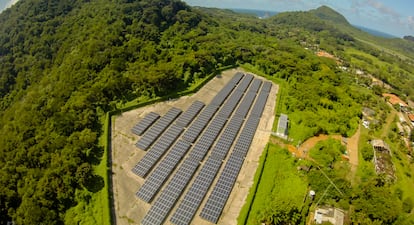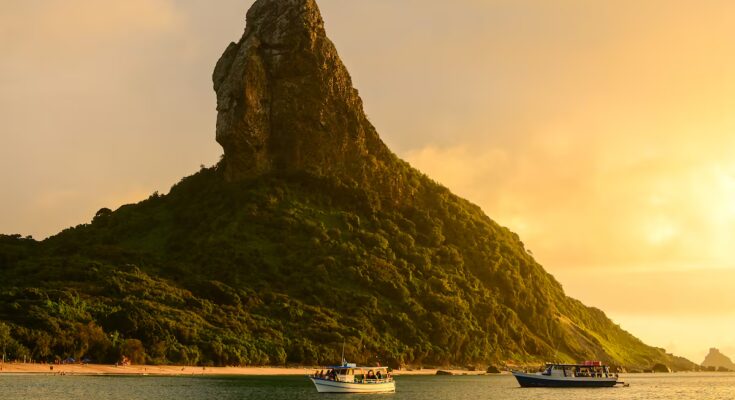The Fernando de Noronha archipelago, 500 kilometers off the north-eastern coast of Brazil, is an isolated natural paradise, a naturalistic jewel not easy to reach and an exclusive destination known for its deserted beaches and rich seabed. A challenge is also to provide electricity to the 3,000 inhabitants who live on the main island and the thousands of tourists. The lights that illuminate the contested restaurants and guesthouses have a downside: ships loaded with diesel that cross the Atlantic every few days to burn the fuel in a thermoelectric power plant. That reality, however, has its days numbered. A project by Neoenergia, the Brazilian subsidiary of Iberdrola, presented this Saturday, aims to decarbonise the island in 2027 by betting on solar energy.
Today, lighting the island means burning 27,000 liters of diesel every day. Some solar systems already exist, but they represent just 5% of the energy consumed. Neoenergia hopes to overturn the percentages in a short time. The construction of two new photovoltaic systems, larger and more efficient than the current ones, will allow us to wean ourselves almost completely from fossil fuels. When they are all operational, in the first half of 2027, according to the project, the emission of 22,000 tons of CO2 will be avoided every year Green Noronhaand presented on the island, on a trip organized by the energy multinational.
According to the company, this heavenly place will become “the first inhabited oceanic island in Latin America” to live exclusively on renewable energy. From the fort of Nossa Senhora dos Remedios, on the island, the president of Iberdrola, Ignacio Galán, celebrated the start of the project: “It is an example of how to transform reality and leave a legacy for future generations”, he said surrounded by authorities and neighbors, fresh from the climate summit in Belém, which brought together more than 50 heads of state and government.
The new plants are expected to generate enough energy to supply the island even at night, because it will be stored in batteries with an autonomy of 14 hours. They will have a peak generation capacity of 22 megawatts, but even so the renunciation of fossil fuels will not be total. The current thermal power plant will be maintained just in case, to activate it when there are many cloudy days or during peak demand periods, such as at the end of the year, when the island is packed with tourists.
The new solar plants will cost 350 million reais ($6.5 million) and occupy land equivalent to 25 football fields on an extremely fragile island declared a UNESCO World Heritage Site. Those responsible assure that they will build in areas not protected by the national park and that in any case they will only affect 1.5% of the island’s total. Other options, such as wind farms, have been ruled out due to their impact on bird migration routes. Nor has there been a strong commitment to solar panels on the roofs of homes and hotels because they do not provide energy consistently.
The project Green Noronha of the Brazilian branch of Iberdrola is part of a broader program that the company has been carrying out on the island for years and which includes initiatives such as the installation of charging stations for electric vehicles or a center to raise awareness among the island’s children about the advantages of energy saving. With solar panels, energy production will be cheaper because you will save money, especially in logistics, but the company does not yet guarantee that residents will see their electricity bills reduced.

During the presentation of the solar project, local authorities were confident that energy autonomy will help stimulate growth in the coming years. Currently, due to rules agreed between the Pernambuco state government and the federal government, the island can only receive 11,000 tourists per month, but the quota agreement is being renewed and the island is confident that the carrying capacity can be increased. The island’s small airport is currently being expanded and the passenger terminal will triple its surface area.
The administrator of the island, Virgilio Oliveira, confessed that the new solar panels can also be a lever to multiply visitors. “Doubling energy capacity is necessary to increase the number of tourists,” he told this newspaper, underlining that he is not looking for exponential growth, but for “sustainable tourism”, compatible with the environment.
The pressure does not stop on Noronha, which always manages to place one of its beaches in the ranking of the “most beautiful in the world”, despite being one of the most expensive destinations in Brazil. Added to the high prices of hotels and restaurants is the entrance fee to the national park (384 reais, just over 70 dollars) and a daily rate of minimum 18 dollars. The homage was created in the late 1980s and aims to preserve the biodiversity of the archipelago.
However, challenges remain: from lack of wastewater treatment to haphazard construction to aggressive exotic bushes that have virtually wiped out native flora. Even the electricity poles with their respective tangles of cables are still standing, visible even in idyllic corners such as Meio beach. At the moment Neoenergia has no intention of burying them.



